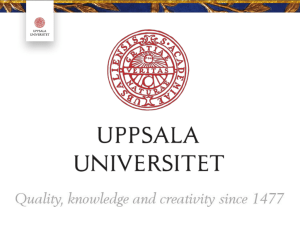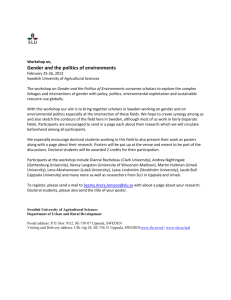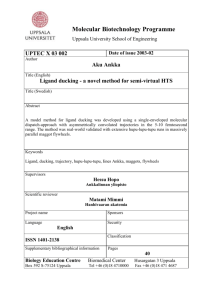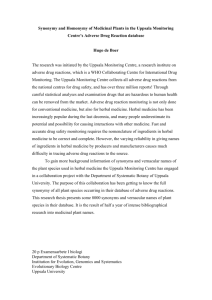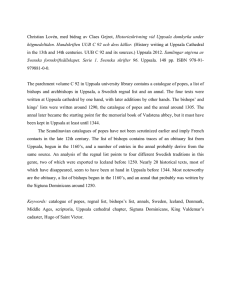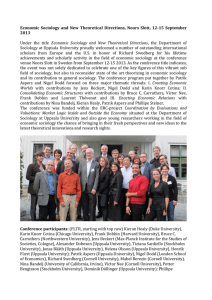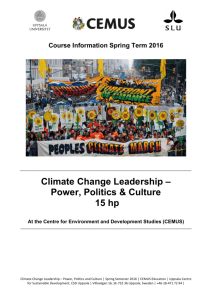Design Project - cemus course portal
advertisement
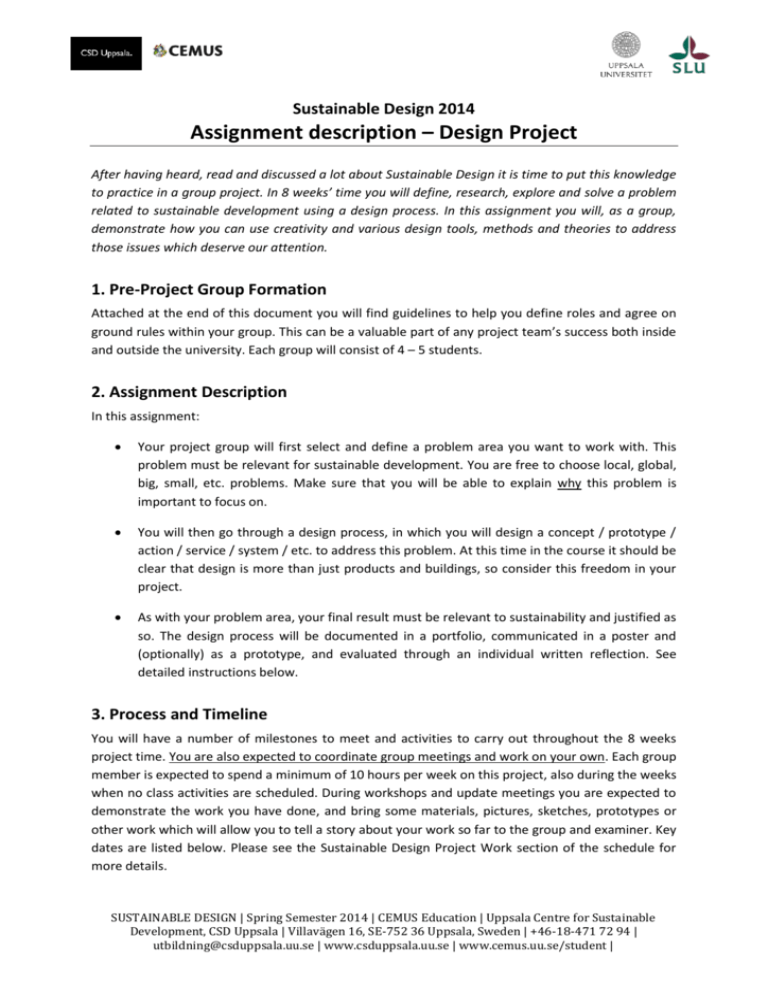
Sustainable Design 2014 Assignment description – Design Project After having heard, read and discussed a lot about Sustainable Design it is time to put this knowledge to practice in a group project. In 8 weeks’ time you will define, research, explore and solve a problem related to sustainable development using a design process. In this assignment you will, as a group, demonstrate how you can use creativity and various design tools, methods and theories to address those issues which deserve our attention. 1. Pre-Project Group Formation Attached at the end of this document you will find guidelines to help you define roles and agree on ground rules within your group. This can be a valuable part of any project team’s success both inside and outside the university. Each group will consist of 4 – 5 students. 2. Assignment Description In this assignment: Your project group will first select and define a problem area you want to work with. This problem must be relevant for sustainable development. You are free to choose local, global, big, small, etc. problems. Make sure that you will be able to explain why this problem is important to focus on. You will then go through a design process, in which you will design a concept / prototype / action / service / system / etc. to address this problem. At this time in the course it should be clear that design is more than just products and buildings, so consider this freedom in your project. As with your problem area, your final result must be relevant to sustainability and justified as so. The design process will be documented in a portfolio, communicated in a poster and (optionally) as a prototype, and evaluated through an individual written reflection. See detailed instructions below. 3. Process and Timeline You will have a number of milestones to meet and activities to carry out throughout the 8 weeks project time. You are also expected to coordinate group meetings and work on your own. Each group member is expected to spend a minimum of 10 hours per week on this project, also during the weeks when no class activities are scheduled. During workshops and update meetings you are expected to demonstrate the work you have done, and bring some materials, pictures, sketches, prototypes or other work which will allow you to tell a story about your work so far to the group and examiner. Key dates are listed below. Please see the Sustainable Design Project Work section of the schedule for more details. SUSTAINABLE DESIGN | Spring Semester 2014 | CEMUS Education | Uppsala Centre for Sustainable Development, CSD Uppsala | Villavägen 16, SE-752 36 Uppsala, Sweden | +46-18-471 72 94 | utbildning@csduppsala.uu.se | www.csduppsala.uu.se | www.cemus.uu.se/student | 6th April Weekend workshop – The Design Process 9th April Workshop I – Starting the project 23rd April Update Meeting I with the course coordinators – during this meeting you will show and discuss your progress with the course coordinators and another group. Bring some materials, pictures, sketches, prototypes or other work which will allow you to tell a story about your work so far. You will be paired with one other group during these meetings. You will have the chance to ask questions, advice and receive feedback and you are expected to actively engage in giving the other group feedback as well. (More instructions will be found on course portal closer to the date) 7th May Update Meeting II with Examiner, Professor Tuula Erikssson – during this meeting you will have the chance to meet the examiner, show your work to her and ask for feedback. Again, you will be expected to actively engage with your partner group in giving an update and feedback as well. (More instructions will be found on course portal closer to the date) 14th May Workshop II – Presenting the project 20th May Deadline 9.00 AM: Submit PDF document of the poster 22nd May Poster Presentation during the Cemus Project Fair 29th May Deadline 17.00 PM: Submit final version group portfolio and individual reflections 4. Requirements You will be required to submit the following for this assignment (explained in more detail below): 1. A portfolio of materials documenting your design process 2. A poster displaying your design and project and (optionally) a prototype, model, demonstration, etc. of the design 3. A presentation of your work at the Cemus Project Fair’, 22nd May 4. An individual written paper in which you will reflect on your work in this project and any insight you have gained on design and sustainability 4.1 Portfolio Many of you will be new to the process of developing a portfolio. What is most important to keep in mind is that your portfolio must be clear for a general audience, e.g. also if people have never heard about your project before. The portfolio is your chance to show that you have put time and effort into your project. SUSTAINABLE DESIGN | Spring Semester 2014 | CEMUS Education | Uppsala Centre for Sustainable Development, CSD Uppsala | Villavägen 16, SE-752 36 Uppsala, Sweden | +46-18-471 72 94 | utbildning@csduppsala.uu.se | www.csduppsala.uu.se | www.cemus.uu.se/student | The portfolio can be submitted in digital format. It may also be submitted in hard copy, as long as it is a well organised document or folder. The portfolio should contain the following: 1. A clear design brief / problem definition. This is a 1 page document with text and/or images that will help you to specify your problem area further. Use ‘WWWWWH’ from the Delft Design Guide, you will find this in your course reader, to assist you in this process. 2. Documentation of your process. This includes photographs, pictures, creations, written work, and other records of activities and actions you carried out during your design process. This documentation must show your progression throughout the entire project, which is described in more detail below. The portfolio is not just a showcase for your final design. Also include ideas, sketches, prototypes, etc. you were not satisfied with or did not continue to develop. When you use methods, techniques, information, etc. from other sources (whether they come from the course or not) always refer to them properly as you are used to doing in other university assignments. Visual and creative work, and photographs should be clearly labelled for a reader who is not familiar with your project – always specify whether it is your own work or not, if not provide the source. Your process must include the following and each step should be documented in the portfolio: o Introduction o Research o Forming the design brief o Idea generation o Idea selection o Concept development o Final design, including one or more visuals o Written summary of final design o Reference list 4.2 Poster Presentation The poster should: Show your design to a viewer who is completely unfamiliar with your project. You will have a chance to present the poster to this kind of audience. The examiner, prof. Tuula Eriksson, will also attend the poster presentations, so make sure that you are able to explain your final design to her clearly. SUSTAINABLE DESIGN | Spring Semester 2014 | CEMUS Education | Uppsala Centre for Sustainable Development, CSD Uppsala | Villavägen 16, SE-752 36 Uppsala, Sweden | +46-18-471 72 94 | utbildning@csduppsala.uu.se | www.csduppsala.uu.se | www.cemus.uu.se/student | You do not have to include the complete design process, but focus on the most important parts which influenced your design. Most likely the audience will want to know why you have made specific design decisions. All posters must be A1. 4.3 Individual Insight Each group member must submit an individual reflection on what you have learned during this design project. Focus on personal development and the insights you have gained during the design process. For example, you may consider: Did you design something new in your project work, and if so how/why were you able to do this? How is the design process different to other ways of approaching problems? Is design a good way of approaching sustainability problems, why/why not? Do you see this, or elements of the design process, as something you can apply in future projects? This reflection must be between 600 – 800 words. Submit your reflection to sdesign@csduppsala.uu.se on the 29th of May at 17.00 the latest. The title of the file should be in the following format: YOURNAME_reflection.pdf 5. Project Options During your project you can work on a problem area you have defined yourself as a group. However, you also have the option to work on some ‘real-life’ cases, or enter a competition, etc. Some are listed below, but you are welcome to find your own. Your own project: form a group of students with similar interests and ambitions for this group project. Develop your own design brief and demonstrate at the project fair how you think this problem area can be addressed. 2014 Smart living challenge (deadline on the 30th of June). Compete in the category ‘Move,’ ‘Eat,’ or ‘Live.’ For more information see: http://2014.smartlivingchallenge.com/ideas 2014 Innovation competition (deadline on the 5th of May, which means more hard work at the start of the project). Design an innovative solution related to environmental technology and the built environment. For more information see: http://www.bygginnovationen.se/sa/node.asp?node=1390 Big Belly Solar Project: Uppsala Kommun has several smart waste bins ‘Big Belly Solar bins’ located around the city. This waste bin is still fairly new and there is a lot of room for improvement. Uppsala Kommun and the distributor of the waste bins are interested to hear your opinion and see your design. SUSTAINABLE DESIGN | Spring Semester 2014 | CEMUS Education | Uppsala Centre for Sustainable Development, CSD Uppsala | Villavägen 16, SE-752 36 Uppsala, Sweden | +46-18-471 72 94 | utbildning@csduppsala.uu.se | www.csduppsala.uu.se | www.cemus.uu.se/student | 6. Deadlines 20th of May at 9:00 (in the morning): submit PDF of A1 poster as GROUP#_Poster.pdf to sdesign@csduppsala.uu.se 29th of May at 17:00 (in the afternoon): submit project portfolio as GROUP#_Portfolio.pdf to sdesign@csduppsala.uu.se 29th of May at 17:00 (in the afternoon): submit individual reflections as YOURNAME_reflection.pdf to sdesign@csduppsala.uu.se PLEASE NOTE: Always include your group number and the names of all group members in the documents you submit. Always include the group number or your name in the title of the document you submit. 7. Resources, Coordinator Support and Work Space The last part of the course reader consists of several articles which can help you during the design process. Also have a look at the original sources: o Delft Design Guide http://ocw.tudelft.nl/courses/product-design/delft-design-guide/course-home/ o IDEO Human Centered Design Toolkit http://www.ideo.com/work/human-centered-design-toolkit/ o Recipes for Systemic Change from Helsinki Design Lab http://helsinkidesignlab.org The following clip can give you a quick overview of a design process from brief to design: o http://www.youtube.com/watch?v=M66ZU2PCIcM Wednesday evenings when no class activities are scheduled the course coordinators will be available at Cemus to answer your questions or provide feedback. Send an e-mail to sdesign@csduppsala.uu.se if you want to schedule an extra group meeting. You will always be able to work in the Cemus library (as long as it is not booked by other courses) as usual. There is a filing cabinet labelled ‘Sustainable Design’ where you can find some materials to help you during this design process. Please keep in mind that we have limited resources, so please make sure you leave enough for other groups to use. SUSTAINABLE DESIGN | Spring Semester 2014 | CEMUS Education | Uppsala Centre for Sustainable Development, CSD Uppsala | Villavägen 16, SE-752 36 Uppsala, Sweden | +46-18-471 72 94 | utbildning@csduppsala.uu.se | www.csduppsala.uu.se | www.cemus.uu.se/student | In the filing cabinet you will also be able to leave sketches, materials, etc. in case you don’t want to carry everything back and forth. In case you leave things behind, mark them clearly with your group names and group number, so things don’t get lost. In the Cemus library you will have enough freedom to brainstorm, make models and prototypes, etc. But please make sure you leave the library the way you found it! 8. Tips and Tricks: important to keep in mind Design projects are very time intensive; the time and energy which was put into the project always shows in the final results. Start on time and work hard. Set regular times to meet each week. This is one of the best ways to ensure constant contact with your group, and an important part of project management in general. People need to know in advance when you will meet so you can plan around these times. Work together as a team. Throughout the course we have discovered several times that a team effort leads to more imaginative, original ideas than individual work. Schedule enough time to actually sit and work together in this project. In a design project you cannot divide the work as you might be able to do with regular group projects (e.g. I’ll do the idea generation and you’ll do idea selection). Don’t be afraid to make mistakes, stupid ideas or to try out something silly. Don’t worry about having the right answer. For each problem there are probably a million ways to solve it. This project is about exploring these different options and developing them. A design project is different from ‘scientific research’ you might be more familiar with. If you’re confused, you’re probably doing the right thing. However, just because this is a creative project, does not mean that there are no requirements for content and quality. Make sure that your work is well-prepared and well-presented. E.g. do spelling and grammar checks, add captions to pictures to indicate what the viewer is looking at and refer to all other work (including scientific articles) with proper references. Since many of you are new to this process, it is normal that you do not know what to do at times. Ask for help if needed and make sure you ask for help on time (not the last day before the deadline). It is your own responsibility to contact the course coordinators if you want an extra meeting (which we can always schedule). SUSTAINABLE DESIGN | Spring Semester 2014 | CEMUS Education | Uppsala Centre for Sustainable Development, CSD Uppsala | Villavägen 16, SE-752 36 Uppsala, Sweden | +46-18-471 72 94 | utbildning@csduppsala.uu.se | www.csduppsala.uu.se | www.cemus.uu.se/student | Design Project Team Contract Sustainable Design 2014 Before you begin what will be an 8 week project, it is important you have a meeting about how you will work in project teams. This will be valuable to you throughout the project as a document to refer back to for your working process. Project management will be part of many of your working lives in future, and effective project teams set goals, expectations, ground rules, and consequences if commitments are not met. You must bring this to your first Mandatory Update Meeting (see schedule in project description above) Team Name: ____________________________________________ Date:_______________________________ GOALS: What are our team goals for this project? What do we want to accomplish? What skills do we want to develop or refine? EXPECTATIONS: What do we expect of one another? E.g. attendance at meetings, participation, frequency of communication, the quality of work etc.? SUSTAINABLE DESIGN | Spring Semester 2014 | CEMUS Education | Uppsala Centre for Sustainable Development, CSD Uppsala | Villavägen 16, SE-752 36 Uppsala, Sweden | +46-18-471 72 94 | utbildning@csduppsala.uu.se | www.csduppsala.uu.se | www.cemus.uu.se/student | GROUND RULES: What rules and policies can we agree on to help us meet our goals and expectations? CONSEQUENCES: How will we address non-performance in regard to these goals, expectations, policies and procedures? We share these goals and expectations, and agree to these policies, procedures, and consequences. Team member name Team member name Team member name Team member name Team member name SUSTAINABLE DESIGN | Spring Semester 2014 | CEMUS Education | Uppsala Centre for Sustainable Development, CSD Uppsala | Villavägen 16, SE-752 36 Uppsala, Sweden | +46-18-471 72 94 | utbildning@csduppsala.uu.se | www.csduppsala.uu.se | www.cemus.uu.se/student |
